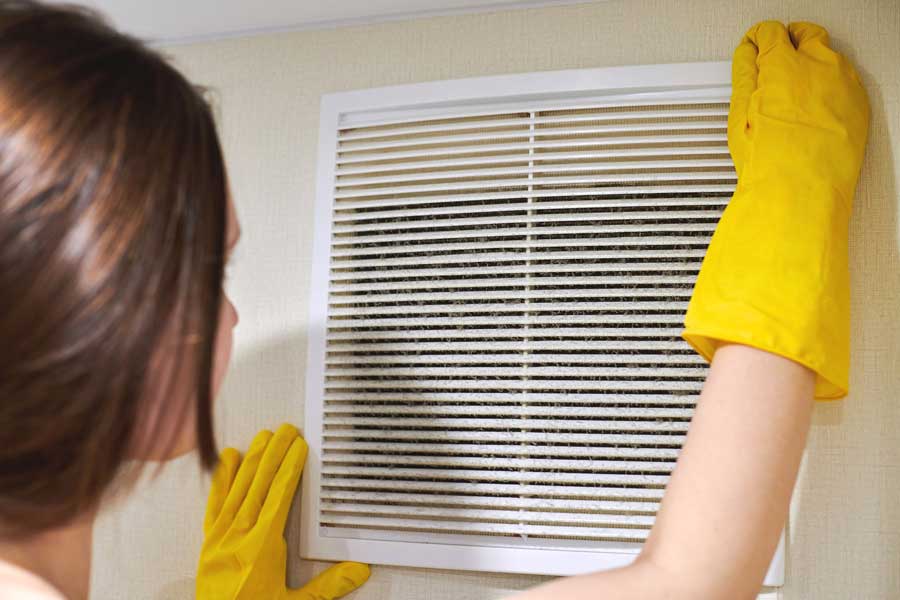Even with a regular cleaning routine, those dusty air vents can be easy to overlook. Not only do they detract from your home’s appearance, but dusty vents can also hinder the efficiency of your HVAC system. Learn more about why vents get dusty, how to keep them clean, and the seasonal considerations that may affect dust accumulation.
Why Do the Vents Get So Dusty?
Before taking out the cleaning supplies, it’s essential to understand why your vents are collecting dust in the first place.
Air Filter
- Replacement Frequency: If your air filter is dirty or hasn’t been changed in a while, it’s time to replace it. At a minimum, replace the air filter every siz months. If you have pets, allergies, or notice regular dust buildup, change it more often.
- Importance of Clean Filter: A clean filter is vital because if it’s dirty, the HVAC system has to work harder to filter the air. The dirt and dust then circulate back through your home, landing on surfaces, including the vents.
Dirty or Inefficient Ductwork
- Professional Cleaning: If dirt, debris, and dust have gathered in your ductwork, it’s time for a deep, professional cleaning. Dusty air vents are an indicator that your ductwork needs attention.
- Replacement Time: With older ductwork, replacement may be necessary. On average, ductwork lasts for about 10-15 years.
- Air Quality Concerns: Dirty ductwork spreads dust throughout your home, with many particles becoming airborne. This can affect air quality, particularly for those with asthma or allergies.
Leaks or Holes in Ductwork
- Efficiency Concerns: Leaks, cracks, or holes in existing ducts reduce air quality, spread dust, and decrease the entire HVAC system’s efficiency.
- Monitoring Energy Bills: An increase in monthly energy bills might signal air leaks in the ductwork. Regular inspection is advisable.
Seasonal Considerations
Different seasons can affect the dust accumulation in your air vents. During spring and summer, pollen and outdoor allergens may contribute to the dust buildup. In contrast, winter might bring more indoor dust from heating systems and reduced ventilation. Understanding these seasonal factors can help in planning a more effective cleaning and maintenance schedule.
Cleaning Dusty Air Vents
After identifying the source of the dust, it’s time to clean those air vents.
Step-by-Step Cleaning Guide
- Use a Damp Cloth: A thorough cleaning with a damp cloth not only tackles dust but prevents it from becoming airborne.
- Air Dry or Use Microfiber Cloth: After cleaning with a damp rag, let the vents air dry or dry completely with a microfiber cloth.
- Utilize a Dryer Sheet: Rub a dryer sheet over the entire surface of the vent to pick up remaining dust and prevent future buildup.
Preventive Measures
Preventing dust buildup is not only about regular cleaning; it’s also about understanding the factors that contribute to dust accumulation and taking proactive measures to minimize them. Whether it’s regular maintenance of your HVAC system or the use of specific products to purify the air, preventive strategies can lead to a cleaner, healthier living environment.
- Regular Maintenance: Keeping a routine check on filters and ductwork can prevent dust accumulation.
- Consider Air Purifiers: Using air purifiers can help in maintaining cleaner air, reducing the dust that settles on the vents.
Conclusion
Don’t let cleaning dusty vents consume your time. Understanding the underlying issues, following the right cleaning methods, and considering seasonal factors can save effort. For professional assistance, schedule a maintenance and cleaning appointment with the HVAC experts at Dale HCS in Santa Rosa. Remember, clean air vents contribute to a healthier living environment and a more efficient HVAC system.

